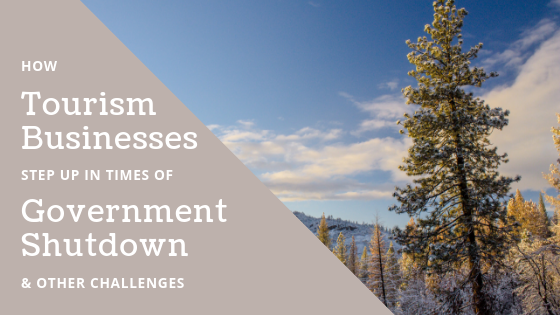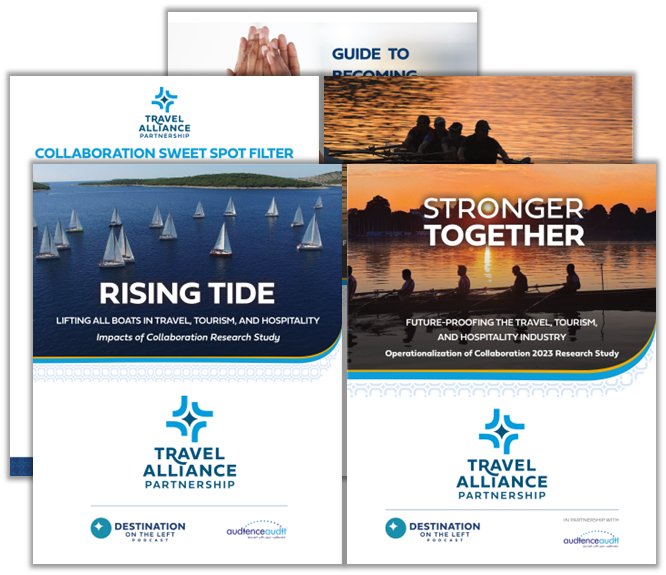How Tourism Businesses Step Up in Times of Government Shutdown & Other Challenges
Travel is designed to fuel discovery, as well as promote a sense of wonder, excitement and curiosity. While the tourism industry can do its best to ensure a trip goes seamlessly, no one is immune from unforeseen disruptions such as political standoff or natural disasters. Let’s look at three examples – present and past – where tourism

“Our reaction to a situation literally has the power to change the situation itself” – Abha Thakur
Government Shutdown Creates National Park Distress
While access to national parks may remain open during the current government shutdown, the absence of government funding for the park services department – whose duties range from clearing the snow trails to ongoing receptacle removal – can quickly pose a negative impact upon visitors.
Rather than succumbing to the situation, tour operators and hoteliers at locations such as Yellowstone National Park have stepped up to volunteer their own time and resources to keep the destination safe and attractive for tourists. Winter isn’t an off-season for the park, with NPR reporting that between 20,000 to 30,000 people a month still come in wintertime, and the snow is a big attraction.
According to Montana Public Radio, Xanterra, which operates the only hotels open inside the park during winter, organized 13 companies that run winter tours in the park to collectively fund nearly $7,500 daily to keep more than 300 miles of snow-covered roads (the only access to Old Faithful and other attractions) groomed. Xanterra is picking up a little over half the tab to keep park roads open, and its employees helped clean public bathrooms at Madison Junction, Canyon Village
Tour Operators Step Up
“There’s a sense of community and empowerment that comes with personally offering your time and talents to be able to maintain and care for a land that you enjoy visiting time after time,” said Jason Murray, owner of Southwest Adventure Tours. An operator currently running tours in five Utah national parks, plus the Grand Canyon and Yellowstone, he adds that the local initiative also shows the care, compassion and appreciation for the visitors who come there.
Murray explains that it’s essential to stay abreast of the latest park information in order to provide the most accurate information to his customers who have already booked trips in the area, and others who now express uncertainty in confirming future excursions. As a member of Travel Alliance Partners (TAP), he looks to his established partnerships with DMOs, such as the Moab Area Travel Council/Visit Utah and The Iron County Office of Tourism, which provide him with detailed updates on the parks’ status on a weekly basis.
In addition to staying well informed, Murray says it’s also important to keep a positive outlook and be adaptable. This isn’t his first rodeo with government shutdowns affecting his business. Murray refers to a former shutdown when tour guides weren’t allowed any access to national parks. “We needed to find areas with similar characteristics and formations to the national parks and take our guests there.”
And if a trip is forced to be canceled? In Murray’s case, some of his guides have welcomed the break to do personal exploring and enjoyed a mini vacation. “It’s finding the silver lining in the cloudy day.”
How can you give back now to national parks to help make a difference?
If you are not working with a DMO in an affected area, donate to the National Park Foundation’s Parks Restoration Fund to support the parks that need the most help.
9/11 Economic Impact on a DMO
Erin Francis-Cummings, President and CEO of Destination Analysts described how challenging times can lead to creativity and resourcefulness on episode 89 of Destination on the Left.
She explained while working at the San Francisco Travel Association how everything came crashing down after 9/11, particularly in San Francisco with the added dot-com crash. “I learned how to work with a very lean budget and be absolutely progressive in thinking about how to accomplish our goals, and also how to take risks,” she said.
Addressing Safety Concerns for Traveling into the U.S.
Francis-Cummings’ current role at Destination Analysts has also faced challenging times. The State of the International Traveler, their annual study that surveys 800 international travelers in 14 key global feeder markets to the U.S., helps the industry look at perceptions and sentiment about the U.S and the country as a travel brand. One of the questions posed to over 11,000 people in 2018 asked, “Why are you not coming to the United States?” Disagreement with U.S. national politics was the main response for international travelers in Europe, while in Asia, she was surprised to learn the main concern was personal safety.
“It’s a big challenge for us to take on at a national level, and I’ve been very proud of the work that U.S. Travel has done in taking this sentiment seriously,” said Francis-Cummings. “They have built a coalition to make sure people have accurate perceptions of the United States. We are doing what we can do to address these types of fears.”
She adds that “in times of challenge, that’s when people are motivated to come together and really wonderful, beautiful things happen.”
Natural Disasters and Philanthropy
Disaster relief is yet another example of how the industry may come together in the face of adversity. As President & CEO of Tourism Cares, Mike Rea helps to unite the industry around critical philanthropic needs and opportunities that are best tackled together.
In episode 56 of Destination on the Left, Rea spoke to his earlier experience working in disaster recovery following the Sri Lanka earthquake and tsunami. Not only was he fascinated, inspired and humbled by the power of disasters, but also the power of recovery, philanthropy and in some cases “building back better.”
A Resource to Help Travelers Give Back Better
Rea also expanded on the travel industry’s care, stewardship and sustainability to the places, cultures and people they love personally and professionally. Through Tourism Cares, he’s been working to make giving and volunteering even more effective and satisfying for travelers, professionals and companies.
One such example is The Good Travels Advisor program, which Rea explains allows travel agents to not only provide a gateway to products, but also cross into the meaning space. The program offers basic tips on giving, volunteering and social experiences of clients and how travel agents engage them.
“The idea was if you’re a travel agent, in addition to providing all the amazing guidance you already do, if there is an opportunity to talk about values, stewardship, what you cared about, why you’re going, especially whether it’s a developing country or not,” said Rea. “A lot of travelers are giving back or thinking about the stuff anyway, so if it can be resource to help travelers give back better, they’re going to see you as a travel agent in a different light.”
Rea goes on to note that they now have a growing community of travel agents with a base level of knowledge in social and philanthropic travel, and there is more to come.
Author
Related Posts
How Tourism Brand Ambassadors Elevate Your Destination Story
In today’s world, it can seem like everything in marketing and sales has changed. But the one thing that hasn’t changed is the value of...
The Rise of Heritage Travel: Finding Cultural Connections
People often say they are traveling to “find themselves,” and heritage travel is quickly becoming one of the most meaningful ways for travelers to explore…
